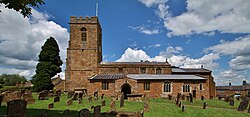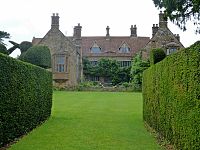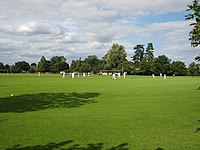Wardington
| Wardington | |
| Oxfordshire | |
|---|---|
 St Mary Magdalene, Wardington | |
| Location | |
| Grid reference: | SP491464 |
| Location: | 52°6’50"N, 1°17’2"W |
| Data | |
| Population: | 602 (2011, with Williamscot) |
| Post town: | Banbury |
| Postcode: | OX17 |
| Dialling code: | 01295 |
| Local Government | |
| Council: | Cherwell |
| Parliamentary constituency: |
Banbury |
| Website: | Wardington.net |
Wardington is a village in the very north of Oxfordshire, half a mile from the border of Northamptonshire to the east and about four miles north-east of Banbury. The village consists of two parts: Wardington and Upper Wardington. It is on a stream that rises in Upper Wardington and flows north to join the River Cherwell.
The parish includes the hamlet of Williamscot, about a mile south-west of Wardington. The 2011 Census recorded this parish's population as 602.
The village has one pub, the Hare and Hounds: other pubs of pas ages have been converted into private homes.
Name
A hundred roll from 1279 records the name as Wardinton. Its etymology is Old English but its meaning is uncertain. "Ward" may be derived from a person called Wearda, or it may be from the Old English wearde or wearda meaning a beacon or cairn.[1] Assuming that it is from a personal name, 'Wardington' means would be from Weardinga tun, meaning 'Village of the sons of Wearda'.
History
The Domesday Book of 1086 records Wardington as part of the Cropredy manor of Remigius de Fécamp, Bishop of Lincoln.[2]
In 1469 in the Wars of the Roses the Battle of Edgecote Moor was fought near Wardington. In 1644 in the Civil War the Battle of Cropredy Bridge was fought across the parishes of Bourton, Cropredy, Prescote and Wardington.[3] The site is now on the Register of Historic Battlefields.[4]
From 1574 Wardington was served by the Free School northeast of Williamscot House.[5] The Free School was closed in 1857 but the building survives.
In 1900 the Great Central Railway's branch line between Culworth and Banbury was built through the southern edge of Wardington parish. In 1911 the railway opened Chalcombe Road Halt more than a mile south of the village on Wardington Road. British Railways closed the halt in 1956 and the line in 1966.
Wardington Memorial Hall was built in 1920 as a monument to villagers who were killed serving in the First World War.[2]
Churches
The Church of England parish church, St Mary Magdalene, has a 12th-century chancel and 13th-century nave. In the 14th century new Decorated Gothic windows were added to the chancel. In the 15th century a Perpendicular Gothic clerestory was added to the nave and a west tower was built.[6]
Monuments in the church include two 14th-century tomb recesses and a 14th-century slab with a foliated cross. There is a 15th-century monumental brass to Henry Freebody, who died in 1444. In the south chapel is an 18th-century monument to George Denton, who died in 1757.[7]
The church was restored in 1887 and 1889 under the direction of the Gothic Revival architect Ewan Christian, and again in 1912–14 under the direction of WT Loveday. St Margaret's is a Grade I listed building.[7]
A congregation of Wesleyans was established in the village by 1815 and had built a chapel by 1827. In 1895 a larger chapel was built in a Gothic Revival style[8] next to the old one, which was sold to the owner of the manor house. The chapel was part of the Methodist Union of 1932. It has since closed and been converted into private homes.
About the village
Between Wardington and Upper Wardington is Wardington Manor house, which dates from the middle of the 16th century or possibly earlier. The house was remodelled in 1665 and twice early in the 20th century. From 1917 Wardington Manor was the seat of Baron Wardington.[9] In 2004 the house was severely damaged by fire but it has since been restored. It is a Grade II* listed building.[10]
Sport
- Cricket: Wardington Cricket Club
Outside links
| ("Wikimedia Commons" has material about Wardington) |
- Wardington.net: Wardington, Williamscot and Coton
References
- ↑ Ekwall 1960, Wardington.
- ↑ 2.0 2.1 Crossley et al. 1972, pp. 210–225.
- ↑ Foard, G; Partida, T (May 2005). "Battle of Cropredy Bridge". Battlefields Trust. http://www.battlefieldstrust.com/resource-centre/civil-war/battleview.asp?BattleFieldId=2.
- ↑ National Heritage List 1000008: Cropredy Bridge (Historic battlefields register)
- ↑ National Heritage List 1287353: Williamscot House, School House (Grade II listing)
- ↑ Sherwood & Pevsner 1974, pp. 822–823.
- ↑ 7.0 7.1 National Heritage List 1228671: Church of St Margaret, High Street (Grade I listing)
- ↑ Sherwood & Pevsner 1974, p. 822.
- ↑ Sherwood & Pevsner 1974, p. 823.
- ↑ National Heritage List 1228757: Wardington Manor (Grade II* listing)
- A History of the County of Oxford - Volume 10 pp 210-225: Parishes: Wardington (Victoria County History)
- Ekwall, Eilert, The Concise Oxford Dictionary of English Place-Names. Oxford, Oxford University Press, 4th edition, 1960. p. Wardington ISBN 0198691033
- Nikolaus Pevsner: The Buildings of England: Oxfordshire, 1974 Penguin Books ISBN 978-0-300-09639-2



